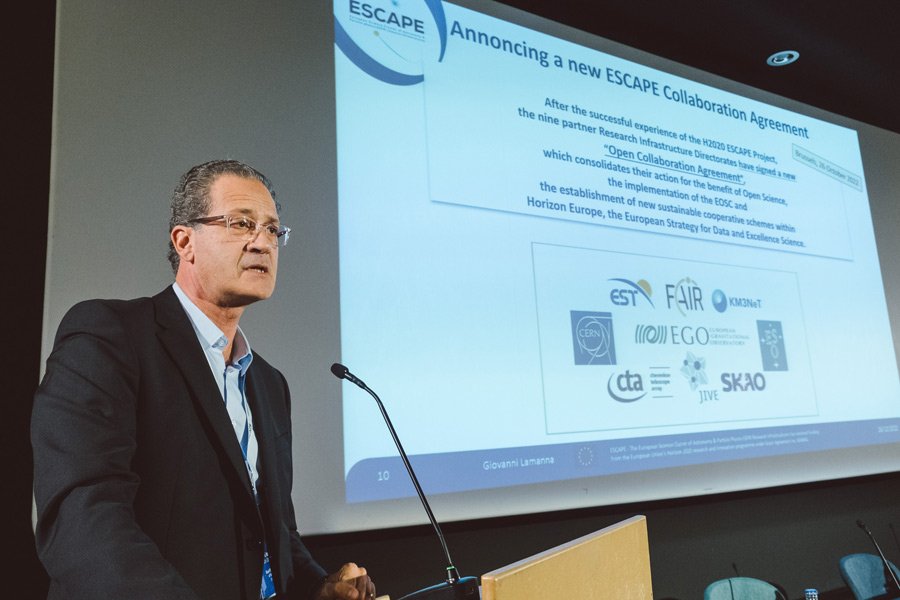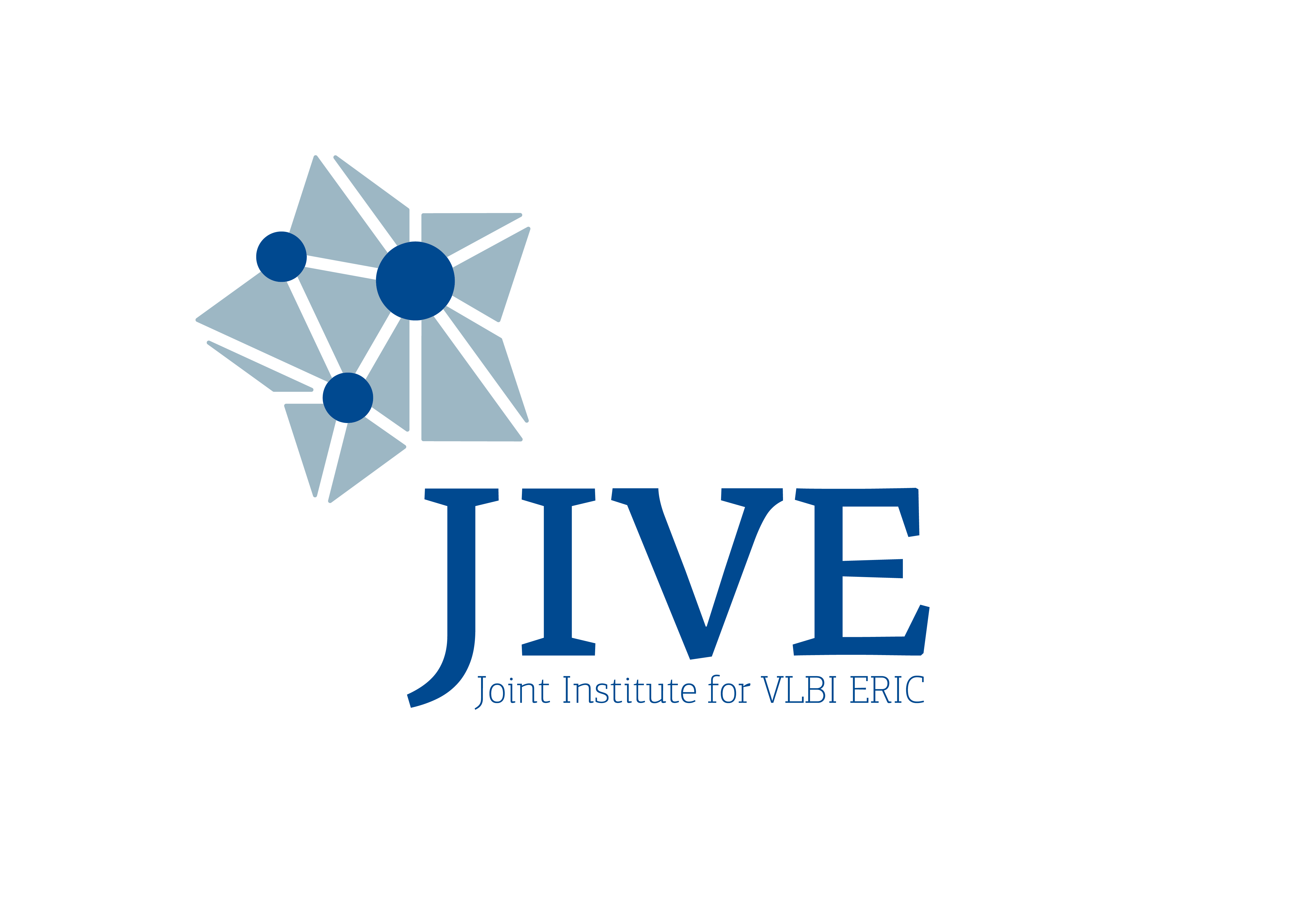
On Wednesday 26 October JIVE joined many of Europe's biggest facilities in physics-related disciplines cementing a long-term deal to commit to sharing and processing open data. This agreement was presented at the “ESCAPE to the Future” conference where partners of the H2020 ESCAPE project as well as members of the scientific community and the European Commission gathered at the Royal Belgian Institute of Natural Science in Brussels (Belgium).
The European Science Cluster of Astronomy & Particle physics ESFRI research infrastructure (ESCAPE) project, initiated in 2019, has brought together a cluster of ESFRI (European Strategy Forum on Research Infrastructures) projects and other world-class research organisations with the aim of implementing a section of a European Open Science Cloud (EOSC) to foster Open Science in astrophysics and particle physics. As the ESCAPE project, funded by a H2020 grant, is coming to its end, the members of the cluster shared their results and achievements, discussed the next challenges and presented an outlook for the future at the ESCAPE to the Future event organised on 25-26 October 2022 in Brussels, Belgium. The event represented the starting point of a new era: after the successful experience of the ESCAPE project, the nine core ESCAPE Research Infrastructure partners have signed a new Open Collaboration Agreement, which consolidates their cross-border action for the benefit of Open Science, the implementation of the EOSC and the establishment of new sustainable cooperative schemes within Horizon Europe for the benefit of the European Strategy for data and excellence science.
During the implementation period of the ESCAPE project, partners from the astronomy, astroparticle, particle and nuclear physics communities have worked together on the development of software for Open Data management, in a cross-border and multi-disciplinary open environment, according to FAIR (Findable, Accessible, Interoperable and Reusable) principles. The “ESCAPE to the Future” event serves as an end point of the H2020 funded project, where partners discussed the achieved goals and future work lines.
“Scientific Research is progressing towards the new paradigm of Open Science for more open, transparent, collaborative and inclusive scientific practices to enhance the impact of science in our society, fostered by the expansion of information and communication technologies. This is the fundamental motivation of the ESCAPE scientific community and it is also the challenge shared by pan-European Research Infrastructures (RIs) that are members of the ESCAPE science cluster,” explains Giovanni Lamanna, Coordinator of the ESCAPE project. “The successful work programme, the achievements and the ability of ESCAPE RIs to cooperate in the context of open data intensive science to lead to new insights and innovation are widely recognised. The ESCAPE RIs are willing to continue cooperative actions by joining their efforts. Bottom-up demands of the involved scientists not to interrupt but to continue the cross-fertilisation in science and innovation that ESCAPE has been able to build, are strongly considered. For these reasons a new ESCAPE open collaboration agreement is established.”
The participation of JIVE in the ESCAPE project has been very valuable for the institute and the European VLBI Network (EVN). Highlights include the JIVE involvement in defining standards such as metadata for software, radio visibility data in the Virtual Observatory as well as improving the Jupytercasa entry in the Open Source Software Registry, making the EVN Archive findable and searchable in the Virtual Observatory and providing an analysis platform for (EVN) visibility data using CASA in version-controlled Jupyter notebooks.
“It was amazing to see how the work done in three different work packages in the ESCAPE project culminated into a coherent science analysis platform for EVN data reduction by the end of the project: the Jupyterhub at JIVE," says Marjolein Verkouter, JIVE Head Technical Operations and R&D Group. "The focus, resources, and expertise provided by the ESCAPE project and its partners was instrumental to bringing VLBI data reduction into the 21st century. We believe these developments address both the “barrier to entry for novel users” as well as providing a clear path forward to deal with future data reduction challenges.”
The new Open Collaboration Agreement, publicly announced during the “ESCAPE for the Future” event and signed by all the Directors of all the research infrastructure partners, will take effect from January 2023, and will also help continue the synergies and joint work of all five domain-based Science Clusters (see paragraph “ESFRI Clusters” below) involved in the implementation of EOSC. The agreement is also open to further research infrastructures to join. This agreement is expected to maintain the collaborative and human experience represented by the Science Cluster and strengthen the role and impact of astronomy and nuclear/particle physics in the field of open science and, more broadly, in the European Research Area.
The first RIs that have signed the ESCAPE Open Collaboration agreement include ESFRI projects/landmarks and research infrastructures such as the European Organization for Nuclear Research (CERN), the Cherenkov Array Telescope Observatory (CTAO), the KM3NeT Research Infrastructure (KM3NeT), the European Gravitational-Wave Observatory (EGO-Virgo), the European Southern Observatory (ESO), the European Solar Telescope (EST), the Facility for Antiproton and Ion Research (FAIR), the Joint Institute for VLBI-ERIC (JIV-ERIC) and the Square Kilometre Array Observatory (SKAO).
Additional information
ESCAPE brings together the astronomy, astroparticle and particle physics communities. With this, ESCAPE puts together a cluster with ESFRI projects with aligned challenges of data-driven research, with demonstrated capabilities in addressing various stages of data workflow and concerned with fundamental research through complementary approaches. ESCAPE aims to produce versatile solutions, with great potential for discovery, to support the implementation of EOSC thanks to open data management, cross-border and multi-disciplinary open environment, according to FAIR (Findable, Accessible, Interoperable and Reusable) principles. The ESCAPE foundations lay on the capacity building of the ASTERICS project work towards enabling interoperability between the facilities, minimising fragmentation, encouraging cross-fertilisation and developing joint multiwavelength/multi-messenger capabilities in astronomy, astrophysics and particle astrophysics communities.
European Open Science Cloud (EOSC) is a cloud for research data in Europe allowing for universal access to data; a single online platform where all European researchers will be able to: (i) find, access and re-use data produced by other scientists; (ii) deposit, analyse and share data they have been paid to produce. EOSC will help increase recognition of data intensive research and data science. Its architecture is developed as a data infrastructure serving the needs of scientists, providing both common functions and localised services delegated to community level. EOSC will federate existing resources across national data centres, European e-infrastructures and research infrastructures by gradually opening up its user base to the public sector and industry.
Five ESFRI clusters projects were launched in 2019, within the H2020 framework of the European Union, providing a gathering point for various ESFRI projects and landmarks to connect to the EOSC. The five Science Clusters are ENVRI-FAIR for environmental research, EOSC-Life for life sciences, ESCAPE for astronomy, particle physics and nuclear physics, PaNOSC for multidisciplinary scientific analysis based on light and neutron sources facilities and SSHOC for social sciences and humanities. The ESFRI science cluster projects implement interfaces to integrate computer and data management solutions to create cross-border, interdisciplinary and open cooperation spaces for European researchers.
The European VLBI Network (EVN) is an interferometric array of radio telescopes spread throughout Europe, Asia, South Africa and the Americas that conducts unique, high-resolution, radio astronomical observations of cosmic radio sources. Established in 1980, the EVN has grown into the most sensitive VLBI array in the world, including over 20 individual telescopes, among them some of the world's largest and most sensitive radio telescopes. The EVN is composed of 13 Full Member Institutes and 5 Associated Member Institutes.
The Joint Institute for VLBI ERIC (JIVE) has as its primary mission to operate and develop the EVN data processor, a powerful supercomputer that combines the signals from radio telescopes located across the planet. Founded in 1993, JIVE is since 2015 a European Research Infrastructure Consortium (ERIC) with seven member countries: France, Italy, Latvia, the Netherlands, United Kingdom, Spain and Sweden; additional support is received from partner institutes in China, Germany and South Africa. JIVE is hosted at the offices of the Netherlands Institute for Radio Astronomy (ASTRON) in the Netherlands.
Image
ESCAPE Coordinator Giovanni Lamanna announces the new ESCAPE open collaboration agreement. Credit: ESCAPE Project.
Contacts
Marjolein Verkouter
JIVE Head Technical Operations and R&D Group
verkouter@jive.eu
Jorge Rivero González
JIVE Science Communications Officer
rivero@jive.eu
Giovanni Lamanna
Director LAPP Laboratory, CNRS-IN2P3/USMB
ESCAPE Coordinator
giovanni.lamanna@lapp.in2p3.fr
